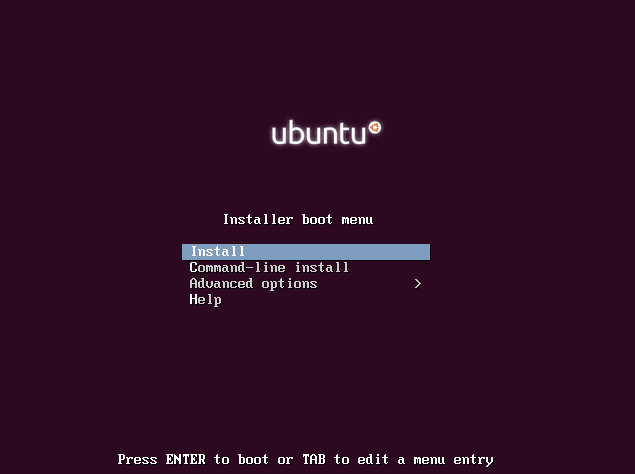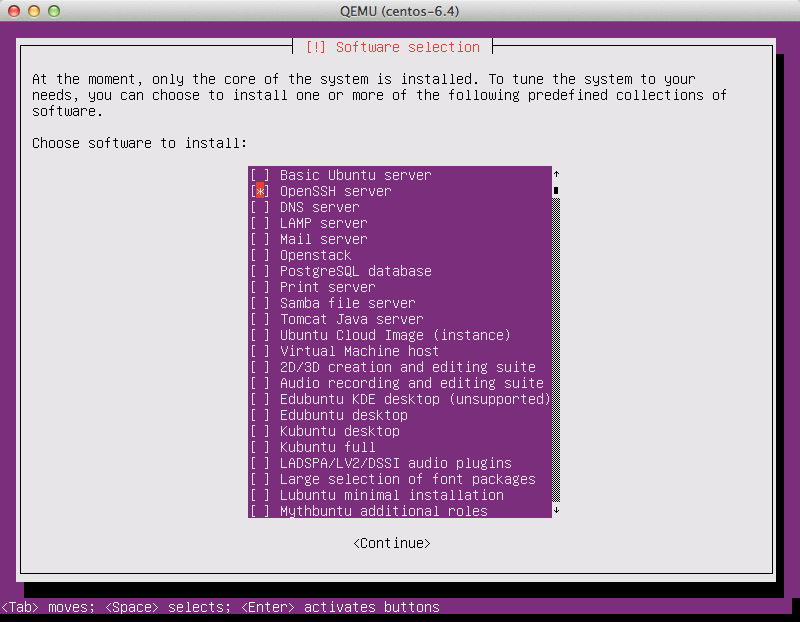6.9 KiB
Example: Ubuntu image
This example installs an Ubuntu 18.04 (Bionic Beaver) image. To create an image for a different version of Ubuntu, follow these steps with the noted differences.
Download an Ubuntu installation ISO
Because the goal is to make the smallest possible base image, this example uses the network installation ISO. The Ubuntu 64-bit 18.04 network installation ISO is at the Ubuntu download page.
Start the installation process
Start the installation process by using either virt-manager or virt-install as described
in the previous section. If you use virt-install, do not forget to connect your VNC
client to the virtual machine.
Assume that the name of your virtual machine image is
ubuntu-18.04, which you need to know when you use virsh commands to
manipulate the state of the image.
If you are using virt-manager, the commands should look something
like this:
# wget -O /var/lib/libvirt/boot/bionic-mini.iso \
http://archive.ubuntu.com/ubuntu/dists/bionic/main/installer-amd64/current/images/netboot/mini.iso
# chown libvirt-qemu:kvm /var/lib/libvirt/boot/bionic-mini.iso
# qemu-img create -f qcow2 /var/lib/libvirt/images/bionic.qcow2 10G
# chown libvirt-qemu:kvm /var/lib/libvirt/images/bionic.qcow2
# virt-install --virt-type kvm --name bionic --ram 1024 \
--cdrom=/var/lib/libvirt/boot/bionic-mini.iso \
--disk /var/lib/libvirt/images/bionic.qcow2,bus=virtio,size=10,format=qcow2 \
--network network=default \
--graphics vnc,listen=0.0.0.0 --noautoconsole \
--os-type=linux --os-variant=ubuntu18.04Step through the installation
At the initial Installer boot menu, choose the Install option. Step
through the installation prompts, the defaults should be fine.

Hostname
The installer may ask you to choose a host name. The default
(ubuntu) is fine. We will install the cloud-init package
later, which will set the host name on boot when a new instance is
provisioned using this image.
Select a mirror
The default mirror proposed by the installer should be fine.
Step through the install
Step through the install, using the default options. When prompted
for a user name, the default (ubuntu) is fine.
Partition the disks
There are different options for partitioning the disks. The default
installation will use LVM partitions, and will create three partitions
(/boot, /, swap), and this will work fine.
Alternatively, you may wish to create a single ext4 partition, mounted
to "/", should also work fine.
If unsure, we recommend you use the installer's default partition scheme, since there is no clear advantage to one scheme or another.
Automatic updates
The Ubuntu installer will ask how you want to manage upgrades on your system. This option depends on your specific use case. If your virtual machine instances will be connected to the Internet, we recommend "Install security updates automatically".
Software selection: OpenSSH server
Choose OpenSSH server so that you will be able to SSH
into the virtual machine when it launches inside of an OpenStack
cloud.

Install GRUB boot loader
Select Yes when
asked about installing the GRUB boot loader to the master boot
record.

For more information on configuring Grub, see the section called
"write-to-console".
Log in to newly created image
When you boot for the first time after install, it may ask you about
authentication tools, you can just choose Exit. Then, log in as admin user using the
password you specified.
Install cloud-init
The cloud-init
script starts on instance boot and will search for a metadata provider
to fetch a public key from. The public key will be placed in the default
user account for the image.
Install the cloud-init package:
# apt install cloud-initWhen building Ubuntu images cloud-init must be explicitly configured for the
metadata source in use. The OpenStack metadata server emulates the EC2
metadata service used by images in Amazon EC2.
To set the metadata source to be used by the image run the dpkg-reconfigure command
against the cloud-init package. When prompted select the
EC2 data
source:
# dpkg-reconfigure cloud-initThe account varies by distribution. On Ubuntu-based virtual machines,
the account is called ubuntu. On Fedora-based virtual
machines, the account is called ec2-user.
You can change the name of the account used by
cloud-init by editing the /etc/cloud/cloud.cfg
file and adding a line with a different user. For example, to configure
cloud-init to put the key in an account named
admin, use the following syntax in the configuration
file:
users:
- name: admin
(...)Shut down the instance
From inside the instance, as root:
# /sbin/shutdown -h nowClean up (remove MAC address details)
The operating system records the MAC address of the virtual Ethernet
card in locations such as
/etc/udev/rules.d/70-persistent-net.rules during the
installation process. However, each time the image boots up, the virtual
Ethernet card will have a different MAC address, so this information
must be deleted from the configuration file.
There is a utility called virt-sysprep, that performs various cleanup tasks
such as removing the MAC address references. It will clean up a virtual
machine image in place:
# virt-sysprep -d bionicUndefine the libvirt domain
Now that the image is ready to be uploaded to the Image service, you
no longer need to have this virtual machine image managed by libvirt.
Use the virsh undefine vm-image command to inform
libvirt:
# virsh undefine bionicImage is complete
The underlying image file that you created with the qemu-img create command,
such as /var/lib/libvirt/images/bionic.qcow2, is now ready
for uploading to the Image service by using the openstack image create
command. For more information, see the Glance
User Guide.